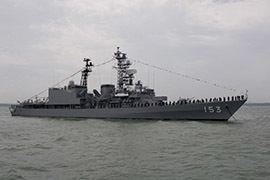The Asagiri-class destroyer was built during the 1980s for service with the Japanese Maritime Self Defense Force.
This class of general purpose destroyer is an extended version of its predecessor Hatsuyuki-class destroyers, and is mainly tasked with ASW and ASUW. The Asagiri-class vessels feature several enhancements and/or improvements over the Hatusyuki class, such as:
COGAG Propulsion System.Compared with the COGOG propulsion system of the
Hatsuyuki class, this class has the COGAG propulsion system with enhanced capacity. The COGAG propulsion system is composed of four Kawasaki-
Rolls-Royce Spey SM1A
gas turbines.
Advanced radar systems.This class is equipped with the OPS-28 surface search radar. The OPS-28 is analogous to the American Target Acquisition System Mk.23 with the Track while scan capability. Later ships of this class introduced the
OPS-24 air search 3D radar. The OPS-24 is the first shipboard
active electronically scanned array radar in the world.
Full-configuration destroyer CDS.The earlier batch was equipped the OYQ-6 combat direction system (CDS). This system employed one AN/UYK-20 computer as the same as OYQ-5 tactical data processing system of the
Hatsuyuki class, but it can exchange tactical data via Link-11, which the OYQ-5 does not support. Later, all OYQ-6 systems were upgraded to the OYQ-7, integrated with OYQ-101 ASW Direction System.All ships of this class were later retrofitted with the terminal for the MOF system, the key operational C4I system of the JMSDF which uses the Superbird SHF-SATCOM.
Enlarged aircraft facility.The
hangar is enlarged in order to accommodate two helicopters, but generally only one helicopter is used operationally.
Asagiri, Yūgiri, and Amagiri were named after World War II destroyers. Amagiri's World War II namesake rammed and sank PT-109.
The Yamagiri and Asagiri have been converted into training vessels.

